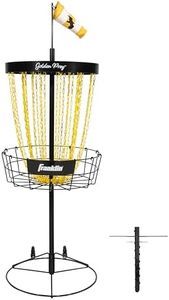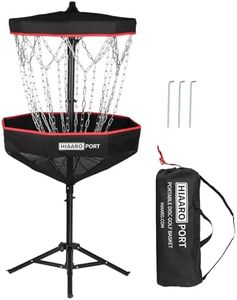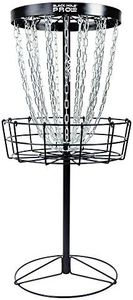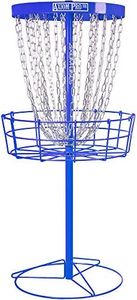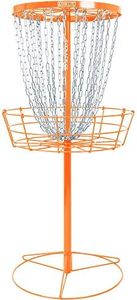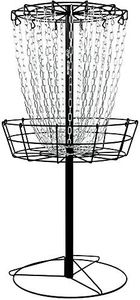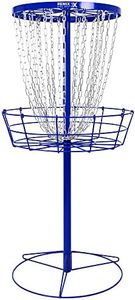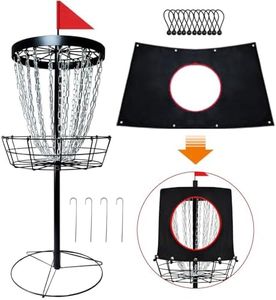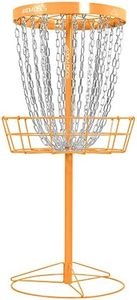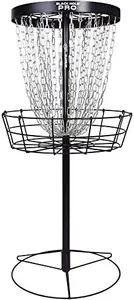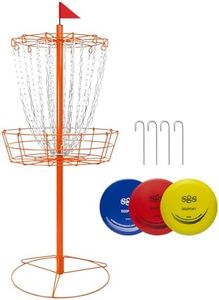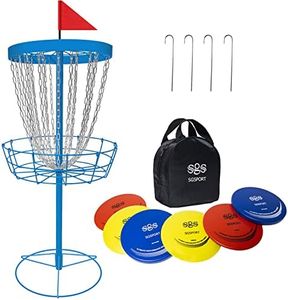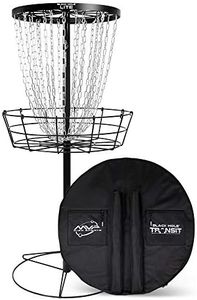We Use CookiesWe use cookies to enhance the security, performance,
functionality and for analytical and promotional activities. By continuing to browse this site you
are agreeing to our privacy policy
10 Best Portable Disc Golf Baskets
From leading brands and best sellers available on the web.Buying Guide for the Best Portable Disc Golf Baskets
Choosing a portable disc golf basket is all about matching your practice needs and playing environment with the features that matter most. Portable baskets are great for setting up practice sessions at home, in the park, or anywhere you have space and permission. They come in many designs and sizes, so it's important to understand which features will help you get the most out of your practice sessions and keep the basket convenient for you to use, pack, and transport.PortabilityPortability refers to how easy it is to move and transport the basket from place to place. Some baskets are lightweight and can be folded or broken down into small components, making them ideal for taking to different practice locations or storing away when not in use. Others are sturdier and heavier, which can be good if you usually keep the basket in one spot and want it to stay put during windy conditions. If you like to practice in various locations or need to store your basket often, choose one that is specifically designed to be easy to carry and assemble.
Chain ConfigurationThe chain configuration describes how many chains are used and how they are arranged around the catching area of the basket. More chains generally mean more reliable catching and less chance of the disc slipping through. Basic baskets might have a single row of chains, while higher-quality models may feature two layers for better catching. If you're just practicing simple throws, a basic setup can work, but if you want a more realistic practice experience closer to what official courses use, look for baskets with more chains and a dual-layer design.
StabilityStability is about how well the basket stays upright and in position when hit by a disc or affected by wind. Stable baskets typically have a wider base or use heavier materials, while lighter, more portable options may tip over more easily. If you plan to use the basket outdoors on uneven ground or in windy spots, look for one with a solid base system. For indoor use or for young kids, a lighter base may be perfectly sufficient and easier to move.
Assembly and SetupAssembly and setup indicate how quickly and easily you can put the basket together and take it apart for transport. Some portable baskets can be unfolded or set up in a minute or two, while others require more time or tools. If you value convenience or need to move your basket regularly, a simple, tool-free setup is best. For those who plan to set the basket up once and leave it, assembly speed may not be as important.
Material and DurabilityThis refers to what the basket is made from, such as metal, plastic, or a mix of both. Metal baskets usually mimic professional designs and last longer outdoors, but they are heavier. Plastic or fabric components make baskets lighter and more portable but might not be as long-lasting if left outside. Think about where you'll use the basket most—if it will stay outside, pick something weather-resistant; if you'll use it indoors or for quick sessions in a park, a lighter model may be enough.
Size and Target AreaThe size and target area determines how closely the basket matches official course baskets and how challenging it is to practice with. Full-size baskets are better for realistic practice, while smaller versions challenge accuracy or make for easy transport. Think about your goals: If you're practicing for tournaments, a regulation-sized basket is ideal. If you're using it casually with friends or family, smaller or mini versions are fine and easier to bring along.

